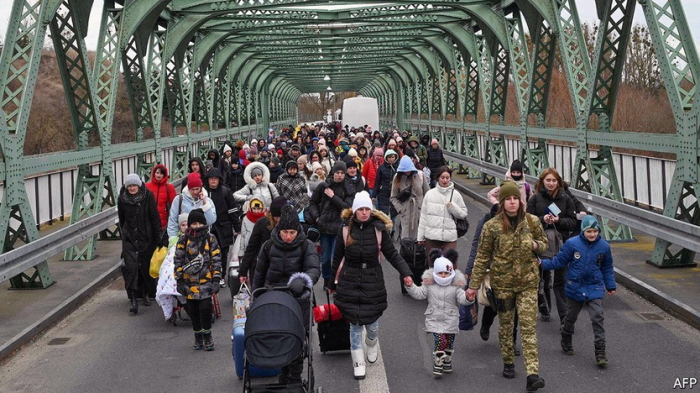Avast evacuation of Ukraine is underway, with Russian guns shelling fleeing civilians. The United Nations High Commissioner for Refugees, Filippo Grandi, says Ukraine is the fastest-growing refugee crisis he has seen in 40 years: 2.5m people fled to neighboring countries between February 24th and March 10th, 1.5m to Poland alone.
That is more than double the number of Rohingya Muslims driven from Myanmar in 2017 (see chart). The UNHCR says the number may rise to 4m, which would equal the second-largest group of contemporary refugees, those from Venezuela. The European Union is even more pessimistic, saying 5m-7m may flee, which would be the same as the record number that has fled the bloodletting in Syria. Vitali Klitschko, the mayor of Kyiv, said on March 10th that half of the capital city’s population had left. Given the pace of displacement, Europe is facing its largest refugee crisis since the second world war.
All refugees suffer. Women and girls tend to suffer more than men, says the UNHCR. It says that females make up half of most refugee flows. But in Ukraine, they are the vast majority. Men aged 18 to 60 are subject to conscription and banned from leaving the country. The elderly tend to be reluctant to undertake long, dangerous journeys. The outflow of women and children is changing Ukraine now and, unless the war ends soon, could change it profoundly and permanently.
Ukraine is a country of 44m people (this is the UN’s estimate for 2020; it includes Crimea, annexed by Russia in 2014). Females are 54% of the total since Ukrainian men die ten years earlier than women. If you cut up the pie by age groups, children below 15 account for 16%. The total of all children and all women aged 15 to 54 comes to about 45% of the population or just under 20m people. So as many as one in ten women and children could have left the country in two weeks.
It is plausible to think that most refugees come from areas that Russians are shelling. The population of the seven oblasts, or regions, which Russia has captured or where its forces have advanced is 11.2m. (This group excludes the breakaway oblasts of Donetsk and Luhansk where population figures are dubious and people who wanted to flee Russian invaders probably did so years ago.) Assuming women aged 15-54 and children below 15 account for roughly the same share of these seven oblasts as they do of Ukraine’s general population, there would be about 5m of them in the conflict zone. If all 2m refugees had come from among this group, that means 40% of the region’s women and children would have left. That is perhaps too large a share since some refugees will have come from elsewhere and some are men. But 2m also understates the true number of refugees since the figure does not include the internally displaced who have not reached Ukraine’s borders. They could number in their millions, with an estimated 300,000 in Mariupol alone. It seems likely, then, that if the war spreads, a very large proportion of all Ukrainian women and children will leave their homes in search of safety. It could be as much as a fifth.
War disrupts everything in a country, including its demography. Families are broken up, birth rates plummet. With luck, peace is restored, families are reunited and births rise again. If the war ends soon, that may happen in Ukraine. But the country is unusual. Even more than in other post-Soviet states, people have been having fewer children, long before Russia’s invasion. According to Iryna Kurylo, of the Ptoukha Institute of Demography in Kyiv, Ukraine had the lowest fertility rate in Europe in 2021, with women likely to have an average of only 1.2 children during their lifetimes. The EU average is 1.5. The country’s population was falling before the invasion and the burden of aging on young workers is increasing. The exodus that is dividing so many families will therefore come on top of an already disturbed fertility. If the war continues, Ukraine’s demographic decline could accelerate to an extraordinary degree. In the future, the country could have too few workers to keep factories, offices, and public services running, permanently depressing the economy and resulting in too few young adults to look after retired people. That would affect not only the Ukrainians of today but their children and grandchildren.
The Economist
More about:
















































